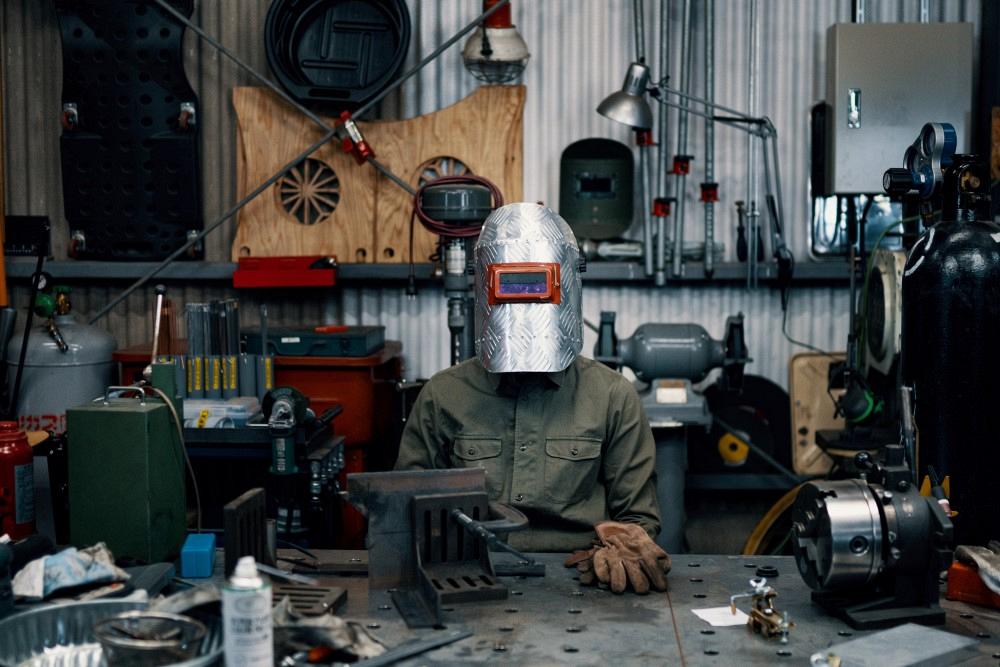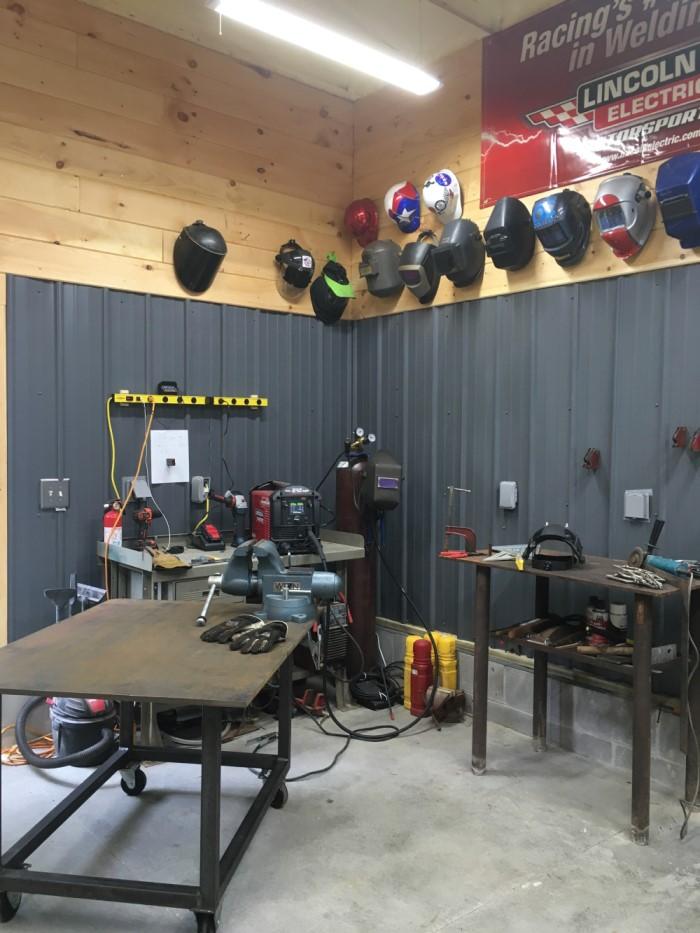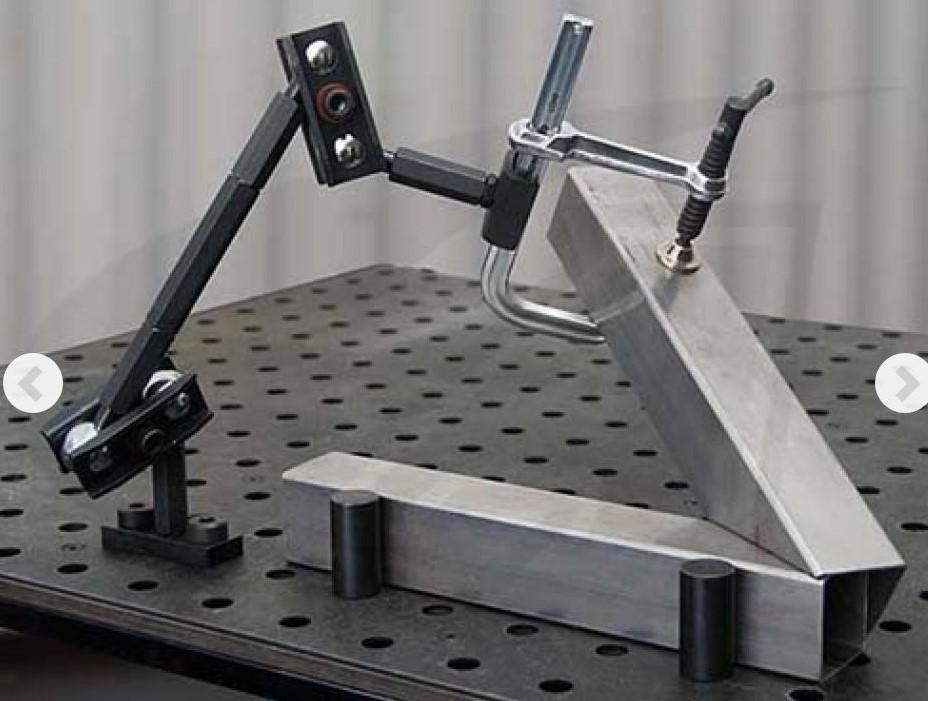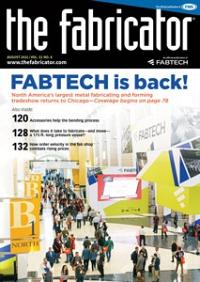Contributing editor
- FMA
- The Fabricator
- FABTECH
- Canadian Metalworking
Categories
- Additive Manufacturing
- Aluminum Welding
- Arc Welding
- Assembly and Joining
- Automation and Robotics
- Bending and Forming
- Consumables
- Cutting and Weld Prep
- Electric Vehicles
- En Español
- Finishing
- Hydroforming
- Laser Cutting
- Laser Welding
- Machining
- Manufacturing Software
- Materials Handling
- Metals/Materials
- Oxyfuel Cutting
- Plasma Cutting
- Power Tools
- Punching and Other Holemaking
- Roll Forming
- Safety
- Sawing
- Shearing
- Shop Management
- Testing and Measuring
- Tube and Pipe Fabrication
- Tube and Pipe Production
- Waterjet Cutting
Industry Directory
Webcasts
Podcasts
FAB 40
Advertise
Subscribe
Account Login
Search
Welders describe what makes the ultimate weld booth
Essentials within reach, good lighting and ventilation, adjustability, dependable tools are key to welding stations
- By Kate Bachman
- August 18, 2021
- Article
- Arc Welding

Working welders describe their dream welding booths and cells to maximize efficiency, including favorite tools, best layouts, safety features, and helpful devices. Getty Images
We asked working welders, “What would your ideal welding booth to maximize your efficiency look like? What tools, arrangement, and furnishings would help you make the work sing? Have you found a tool or device that you have found invaluable?”
Our first response comes from Jim Mosman, who writes The WELDER’s column, "Jim's Cover Pass.” He worked for 15 years as a welder in a small machining and manufacturing company before beginning a 21-year career as a community college welding instructor. After retiring from that, he is now a senior customer training instructor for Lincoln Electric where he conducts "Train the Trainer" workshops for welding instructors around the world.
Other welders’ suggestions and contributions follow.
Jim Mosman
My ideal welding booth or area would be a combination of the areas I have used and currently use at my home shop.
Room Size. The area I use now is approximately 15 by 15 ft. with an additional 20-ft. open area for larger projects and storage of steel material as needed. It has a 20-ft.-high ceiling with the lower 8 ft. being flat gray steel walls constructed of roofing panels. They make the area a bit more fire resistant.
This is my normal layout (see lead image).
Weld Table No. 1. I position my main welding table in the middle of my work area because I can work from all sides and reach across if needed. It is 4 ft. by 4 ft. by 30 in. high. The top is made of ¾-in.-thick steel plate. Two of the corners have a 2-in. radius, and the other two corners have a perfect 90-degree square corner. The legs and base are constructed of 2-in. square tubing, on locking casters for ease of movement. I have a large vise mounted near one of the square corners.
Weld Table No. 2. My second table is 3 ft. sq. by 38 in. high with a 5/8-in.-thick top. This table has an 18-in.-high plate across the back that I use for holding locking pliers, C-clamps, and layout magnets. The height of this table lines up with the vise jaws on Table No. 1. This table has a lower shelf made of expanded metal. I keep my chipping hammers, weld pliers, files, locking pliers, C-clamps, layout magnets, and other hand tools on this shelf for easy reach. This table also has locking casters for ease of movement, but it usually is located against one wall next to my welding power sources.
Tool Bench. This is a small stationary workbench 2 ft. by 4 ft. by 36 in. high. It is against the wall next to the welding power sources. It has a shelf near the bottom for storing electrodes and electrode wire. It also has a drawer for storing consumables for GMAW guns, GTAW torches, plasma, and oxyfuel torches. This bench also has a bench grinder and small benchtop drill press mounted on it.

For The WELDER columnist Jim Mosman, the ideal welding booth layout for small projects comprises three work tables and is made fire-resistant with a metal wall composed of steel roofing panels. Image: Jim Mosman.
I keep two portable 4-1/2-in. grinders (one with a grinding disc and one with a sanding disc), two hand drills (a 3/8 in. and a 1/2 in.), and two air die grinders on this bench. I have a power strip mounted on the wall behind it to charge the portable hand tools. A 50-lb. anvil sits on a stand.
Tool Chests. I use two large tool chests with top boxes. These are situated on the wall opposite the tool bench. One tool chest has all of my mechanic-type tools, such as wrenches, sockets, pliers, hammers, and drill bits. The other tool chest holds my welding-related tools, such as layout and measuring tools, extra clamps, cutting and welding torches and tips, grinding and sanding discs, and extra PPE supplies.
Welding Power Sources. [To learn about innovations in power sources, read “Welding power sources trend toward user utility.”]
- One 300-amp multiprocess welding power source
- One 200-amp GTAW-specific welding power source
- One portable 200-amp multiprocess welding power source
Power Equipment
- One plasma cutting machine for up to 5/8 in. deep
- One oxyacetylene torch cart with a 50-ft. hose
- One portable chop saw
- One large air compressor
Gas Equipment. Cylinders of oxygen, acetylene, argon, and an 80/20 mix are kept outside in a storage area. One cylinder of each shielding gas is chained up in a corner inside the booth near the welding power sources.
Safety, Comfort, Ergonomics
- Two portable welding curtains
- A fire extinguisher
- One portable fume extractor
- A couple of welding stools and chairs
- Four pipe jack stands
- One large portable fan for use in the summer
- One heater for use in the winter
I stock three refrigerators. I use an old refrigerator with a 40-W light bulb to keep my electrodes dry. Another one is used to store paint, acetone, paint thinner, and paint spray cans to keep them away from flames and sparks. I also have one small refrigerator. I use it to keep my drinks cold.
With this equipment and weld booth area, I am able to work on most small projects. Larger items would need to be done in a large shop setting.
Other welders contributed some astute comments about what enhances their efficiencies and makes their welding booths sing.
Darin Talashoma
Even when I worked for others, I never skimped on tools. Air tools are Dotco and Dynabrade because these can be rebuilt. Craftsman tools, ‘cuz if you break them, they'll be replaced. Proto and Snap-on are great tools, but there's no replacement guarantee.
For grinding discs, I mainly worked with aluminum and stainless steel using TIG welding. So I use Scotch-Brite type, 2-in., coarse to very fine cutting discs with carbide-tipped burrs.
I'm a machinist and welder, so I have two rollaways. Kennedy is my preference. Both have five drawers, a riser, and a top box for small detail tools.
Randall Counselman
For ventilation, a downthrough work table is best but expensive. For me, the optimal work table height is 33 to 34 in. The work table should have clamp mounting holes sufficiently spaced or positioned to allow for good accessibility to part joints to be welded.
Tools required include hand grinder, die grinder, power brush, hand brush, pneumatic needle gun, slag hammer, weld pliers, weld gauges, adjustable wrench, screwdrivers, flint striker, weld clamps, C-clamps, box cutter, and pneumatic/hydraulic lift or wedge jacks.
You need a flashlight and full-face grind shield.
The best efficiency-enhancing feature for us is a shop Ethernet cable connection to each weld power supply, and productivity software and shop cameras to monitor work effort and efficiency. Plus that helps to understand work safety incidents and damage sources to work, tools, and equipment.
Shawn Ross

A good weld table has a solid surface, protective screen, drawers for essentials, and is on wheels for mobility.
My ideal welding booth would be arranged for easy cleanup with nothing on the floor to trip over constantly. I would like a large capture zone to shoot my grinding sparks that would collect them for easy disposal. It would have a wall-mounted vacuum to hook a hose to so I could use only the hose and then hang it when I’m done (kind of like a whole-house vacuum with drops).
I like drop-down electrical cords, wall-mounted air hose reels, and articulated wall-mounted theater spotlights so I can adjust the intensity and color of the light onto the task area I am working. The booth would have a really nice rolling, adjustable-height gas-shock tractor seat-style stool made for 600-lb. people with a nice, padded leather cover to sit on. It would include a 5- by 3-ft. self-extinguishing mat to lay on the cold floor with a 4- by 4-ft. kneeling pad of the same material. The best welding screens ever are Screenflex. They are easy to move, set up, and tear down.
The best way I have found for ventilation extraction is to be familiar with the capture zone limits of the intake. Some intake faces only extend a capture zone of 6 to 8 in. Others have a more powerful 12 to 14 in. I like my capture zone to be above the welding zone so that the heat and smoke rise up and draw away from myself and my fellow co-workers. I desire the filtration to be outside the building and treated with carbon to absorb the worst contaminants. Recirculating it through a HEPA filter just means that over time I pollute the inside of the building with heavy metals or metal fumes that the HEPA does not capture.
I find that the Lincoln Electric smooth bore feed hoods with integrated lights are the easiest to adjust and tie into the piping on the walls. I really appreciate a variable speed suction so I can adjust for the process I am using.
Most platen and welding tables lack capacity for weight or adjustability for height. The best commercial off-the-shelf bench I have used is the Miller welding table with a vise and slots for clamps. I am intrigued by the Forster octagonal table but have not had the pleasure of using it. For me, the best height is 40 to 45 in. so I am welding and propping myself up for comfortable, no-back-strain welding.
Essential tools are silver streak pencils and high-purity paint markers in large- and small-diameter tips with red paint; Atlas chipping hammer; blue and black Sharpies; carbide lathe-cutting inserts attached to a handle; carbide scribe; magnetic ground attachment; Strong Hand Tools JointMaster with ball joints mounted to an on/off magnet used with modified vice grips; Makita electrical variable speed die grinder with PERF carbides; and Osborn wire brushes.
Safety must-haves are a TIG finger heat shield, Tilson aluminum heat shield gloves, a Jackson Balder autodarkening helmet, and Phillips Safety Schott filter glass gold-covered fixed lenses.
Jake Shackleton
All jobs need different environments. On some jobs, you need all of your kit around you; on other jobs you need space. I guess the one thing that really helps in TIG welding is a remote foot pedal. On a big job, cables are a pain in the butt!
Arend de Kroon
Welper YS-50 welding pliers help to cut the wire and clean the cup helps. Another favorite is a welder helmet with a fresh-air supply, preferably from ESAB, Speedglas, or Optrel.
Benjamin Spangler
I always found it easier to weld outdoors in the sunlight because I could see the edges of the weld joints so much better. So lighting is a crucial and yet overlooked component of a welding booth. If a new welder can’t see the edges of a V groove weld joint, they will miss them. After years of experience, I learned to lean on my other senses more, so lighting is not as important now, but when I was learning, being able to see what I was welding was everything.
Jason Harvey
Practice 5S and keep the space to a minimum. There is too much wasted time if you have to walk everywhere.
Matt Yarek
Keeping everything in reach helps a lot. Also the right welder and tools help tremendously.
About the Author

Kate Bachman
815-381-1302
Kate Bachman is a contributing editor for The FABRICATOR editor. Bachman has more than 20 years of experience as a writer and editor in the manufacturing and other industries.
Related Companies
subscribe now

The Fabricator is North America's leading magazine for the metal forming and fabricating industry. The magazine delivers the news, technical articles, and case histories that enable fabricators to do their jobs more efficiently. The Fabricator has served the industry since 1970.
start your free subscription- Stay connected from anywhere

Easily access valuable industry resources now with full access to the digital edition of The Fabricator.

Easily access valuable industry resources now with full access to the digital edition of The Welder.

Easily access valuable industry resources now with full access to the digital edition of The Tube and Pipe Journal.
- Podcasting
- Podcast:
- The Fabricator Podcast
- Published:
- 04/16/2024
- Running Time:
- 63:29
In this episode of The Fabricator Podcast, Caleb Chamberlain, co-founder and CEO of OSH Cut, discusses his company’s...
- Trending Articles
AI, machine learning, and the future of metal fabrication

Employee ownership: The best way to ensure engagement

Steel industry reacts to Nucor’s new weekly published HRC price

Dynamic Metal blossoms with each passing year

Metal fabrication management: A guide for new supervisors

- Industry Events
16th Annual Safety Conference
- April 30 - May 1, 2024
- Elgin,
Pipe and Tube Conference
- May 21 - 22, 2024
- Omaha, NE
World-Class Roll Forming Workshop
- June 5 - 6, 2024
- Louisville, KY
Advanced Laser Application Workshop
- June 25 - 27, 2024
- Novi, MI





























